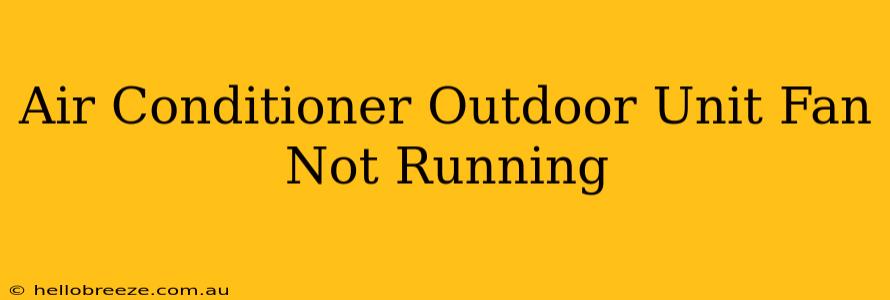Is your air conditioner struggling to keep up, and you've noticed the outdoor unit fan isn't spinning? A non-functional outdoor fan is a serious problem that can lead to overheating and potential damage to your AC unit. This guide will walk you through troubleshooting and potential solutions to get your outdoor fan running smoothly again.
Common Reasons Why Your AC Outdoor Fan Isn't Working
Several factors can cause your air conditioner's outdoor unit fan to fail. Let's explore the most common culprits:
1. Power Supply Issues:
- Tripped Breaker or Blown Fuse: This is the most common and easiest fix. Check your home's electrical panel for a tripped breaker dedicated to your AC unit. Reset it by flipping the switch off and then back on. If you have fuses, replace any blown fuses with the correct amperage.
- Disconnected Wiring: Loose or disconnected wires in the outdoor unit can interrupt power to the fan motor. Carefully inspect all wiring connections for any damage or loose terminals. Warning: If you are not comfortable working with electricity, call a qualified HVAC technician.
- Faulty Capacitor: The capacitor stores energy and helps the motor start. A bad capacitor can prevent the fan from running. This usually requires professional diagnosis and replacement.
2. Mechanical Problems:
- Seized Fan Motor: The fan motor might be seized due to dirt, debris, or bearing wear. This often requires professional repair or motor replacement.
- Broken Fan Blades: Inspect the fan blades for any damage, cracks, or bending. Bent or broken blades can prevent the fan from spinning and should be repaired or replaced.
- Obstructions: Debris such as leaves, twigs, or other items can clog the fan and prevent it from rotating. Carefully clear away any obstructions around the fan blades and motor. Remember to always disconnect the power before attempting any repairs.
3. Refrigerant Issues:
- Low Refrigerant: Low refrigerant levels can cause the system to shut down as a safety precaution. This usually requires professional service to recharge the refrigerant. A leak needs to be found and fixed as well.
- Frozen Condenser Coils: Ice buildup on the condenser coils can restrict airflow and prevent the fan from running. This often points to low refrigerant or a faulty component in the system.
4. Control Board Problems:
- Faulty Control Board: The control board regulates various aspects of the AC system. A malfunctioning board can prevent the fan from starting. Diagnosing a bad control board requires testing and may necessitate professional repair.
Troubleshooting Steps:
- Check the Power Supply: Start by checking the breaker box and ensuring power is reaching the outdoor unit.
- Inspect the Fan Blades and Motor: Look for any obvious damage, obstructions, or signs of seizing.
- Listen for Unusual Sounds: Pay close attention to any unusual noises emanating from the outdoor unit. Grinding or clicking sounds might indicate a mechanical problem.
- Clean the Unit: Remove any debris from around the fan and condenser coils to ensure proper airflow.
When to Call a Professional:
If you've tried these troubleshooting steps and the outdoor fan still isn't working, it's time to call a qualified HVAC technician. Attempting complex repairs without the proper knowledge and tools can lead to further damage and potential safety hazards. Professional diagnosis will pinpoint the exact cause of the problem and provide the most effective solution.
Remember safety first! Always disconnect the power supply before attempting any repairs to your air conditioner.
By understanding the potential causes and following the troubleshooting steps outlined above, you can effectively diagnose and address the problem of a non-functioning outdoor unit fan and get your air conditioner back to cooling efficiently.

